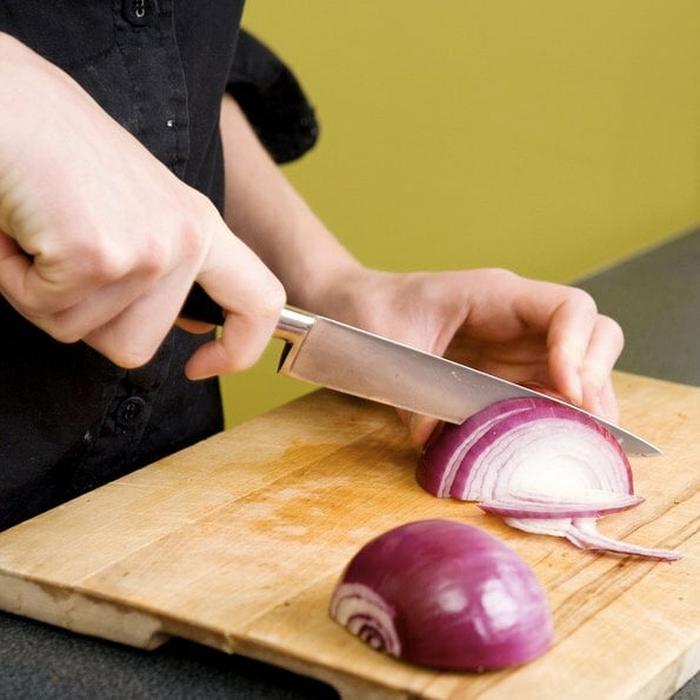
We know: You’re busy. You’ve got a full-time job. You’re trying to have a life. Maybe you’ve even got a spouse and some kids who keep your schedule jam-packed every evening.
So, Superwoman that you are, we’re not suggesting that you need to be a top chef, whipping up gourmet dinners every night. But, there are a few simple kitchen basics you should know—because they can make your life easier, they’ll make cooking much more fun, and they might even help land that promotion when you invite your boss to dinner (hey, it could happen!).
And, well, if nothing else, they’ll save you a lot of money when you’re not ordering takeout every night.
1. How to Make Pasta
Now, I’m not suggesting that you don’t know how to make pasta (um, boil water), but there are a lot of little adjustments that will ensure you make perfect pasta.
First and foremost, always salt the water, and salt it more than you think—as in, about a tablespoon of salt for a 4-quart pot of boiling water. Nobody likes flavorless pasta, and cooking it in salted water will keep that from happening.
Next, while you may have been told to run a little cold water over pasta while you drain it to prevent it from sticking together, don’t—it can leave your noodles with a gummy texture. Plus, it’s actually better for the pasta to be a bit sticky so the sauce clings to it.
Finally, restaurant chefs often say you're not really supposed to fully cook the pasta in the water. Instead, drain it when it's very al dente—which means firm and chewy (but not crunchy)—then add the pasta to the sauce in a skillet. The pasta will finish cooking, and the sauce and flavor will fully permeate each strand.
2. How to Cook Garlic
Garlic is a great staple to have in your kitchen—a dash can really jazz up all kinds of dishes, from salads to stir-fry. But it’s also a little tricky to work with.
First, you have to know how to prep it right. To get the pesky peel off before chopping, smash the clove with the back of a chef’s knife. (This will also help release the oils.) Then, remove the peel and chop. Most recipes call for a very thin slice, like that famous scene in Goodfellas.
It’s also really easy to burn garlic when cooking it. When sautéing, always use a very low heat and remove from heat when the edges of the garlic are the very faintest shade of brown. It will continue to cook a bit in the hot oil, so pulling it off the heat early will prevent over-cooking. You can also add the garlic to the pan after most of the other meat or veggies to give it less chance to burn.
3. How to Chop an Onion
Did you know that knife accidents at home led to ER visits 330,000 times in 2011? None of us have time for that. By knowing how to chop an onion the right way, you’ll be safer—not to mention more efficient—with your cooking. Plus, it looks really impressive.
I’ve found that the easiest way to learn to chop an onion is to watch a video—so I made one for you!
4. How to Make Salad Dressing from Scratch
Homemade dressings make even the most basic salads seem gourmet. And once you realize how easy and cheap it is to make your own dressing, you might just ditch the store-bought stuff altogether! The trick is to keep it very simple—as in, just two or three ingredients, plus the optional dash of salt and pepper.
A classic vinaigrette is the best place to start. For this, you need one part vinegar to three parts oil (e.g., 1 teaspoon vinegar to 1 tablespoon oil). I prefer light olive oil to extra virgin—the texture is less weighty on greens—combined with a very high-quality balsamic vinegar. My favorite is by Wine Country Kitchens and costs about $10 for an 8 oz. bottle, but it's well worth the investment. Just pour the oil and vinegar into a mini Tupperware-style container and shake vigorously to mix. You can adjust the ratio or add salt and pepper until it tastes good to you.
Once you know the basics, variations are simple. You can experiment with different types of vinegars or use citrus juice instead (just increase the ratio to one part juice to one part olive oil). Try adding some chopped garlic or shallots, or a dollop of sour cream or Greek yogurt for a creamier texture.
5. How to Make 2 Signature Dishes
OK, this sounds complex, but I really think every working woman can benefit from having two signature dishes that she feels comfortable serving for guests.
First, you should have a simple recipe—think easy cookies, a yummy dip, or a quick side dish—that you can whip up for a party. You should also have a more complex signature, a main course that you joyfully labor over. Having both of these in your back pocket will prevent you from stressing when you’re asked to make something for a party or office potluck—or when your boss (or your future husband) comes to dinner!
My basic signature is a roasted lemon and garlic Brussels sprouts dish. It’s simple to prepare, garners fans even from non-Brussels lovers, and tastes great hot or cold (great for potlucks). My more complex signature is a Russian Jewish barbecue chicken dish that my grandmother taught me to make. It's a tricky, messy, and complicated recipe—definitely for weekends and special occasions—but the end result is a memorable crowd pleaser!
Don’t have signatures yet? Just start experimenting. Scroll through food magazines and blogs and make a dish that inspires you. If you find yourself wanting to make it again and again (and, others keep begging you to), it’s probably a winner.
Tell us! What are the kitchen tips and techniques that make your life easier?